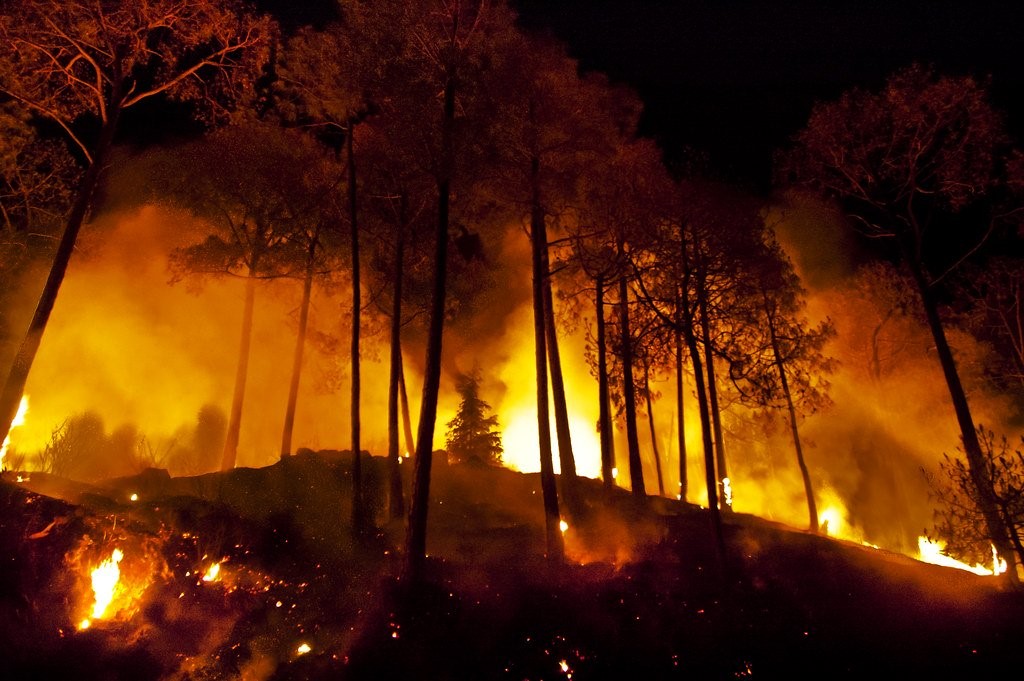Description

Disclaimer: Copyright infringement not intended.
Context
- India’s Himalayan forests are burning amber, instead of being snow-clad this winter.
What is the situation?
- The highest number of fire alerts between January 9 and 16, 2024, in India have been recorded in Uttarakhand.
- A lack of snowfall and rainfall in Uttarakhand has led to an increasing number of forest fires.
- There was no rain or snowfall from January 1-16.
- Nainital recorded a minuscule 0.8 millimetres (mm) of rain, as opposed to the 14 mm that it usually gets.
- Almora and Bageshwar usually record over 15 mm, Chamoli records 20 mm while Rudraprayag and Uttarkashi record 28 and 26 mm of rain respectively.
- However, Chamoli, Uttarkashi, Pithoragarh and other hill districts in Uttarakhand have recorded a 100 per cent deficit in rainfall this time, according to the Dehradun centre of the India Meteorological Department.
- December too was dry, with Uttarakhand receiving 75 per cent less rainfall than normal.
- This has translated into forest fires statewide.
How it will impact?
- A dry winter means Uttarakhand could face major problems in terms of drinking water availability, horticulture as well tourism services.
- The southwest monsoon recharges the waterbodies for the winter whereas the winter precipitation does so for the spring and summer, till the arrival of the monsoon. Since there has been no rain and snow this time, there is bound to be a drinking water problem. There could also be no fodder for livestock.
- Rural women in the state will have to trek several more kilometers than they usually do, in the search for water and fodder.”
- All this could, in turn, affect farming and horticulture in the mountains. Horticulturists are struggling to find water for the fruit-bearing trees planted during the winter.
- The lack of rain has also prevented the sowing of wheat in the hills’ unirrigated fields.
- Those who still want to sow barley, will not be able to do so.
- Most rivers are drying up due to lack of rain. The situation in irrigated fields is also not very promising.
- Precipitation in the form of rain and snow is also tied to the tourism sector in the hiking and ski destination of Auli.
- It has severely affected tourist footfalls.

Analysis of Forest Fires in the Himalayas:
- Forest fires in the Himalayan region have become increasingly prevalent, posing severe ecological and socio-economic challenges.
Ecological Impact:
Biodiversity Loss:
- Data from the Forest Survey of India indicates a steady decline in forest cover in the Himalayan region due to fires.
- For instance, between 2017 and 2019, Himachal Pradesh reported a loss of approximately 826 square kilometers of forest cover.
Erosion and Soil Degradation:
- Soil erosion and degradation data from the Indian Council of Agricultural Research (ICAR) reveal that forest fires contribute significantly to these issues. Loss of topsoil in Uttarakhand, a region prone to forest fires, increased by 15% from 2015 to 2020.
Climate Change Contribution:
- According to the Intergovernmental Panel on Climate Change (IPCC), forest fires in the Himalayas contribute to carbon emissions.
- In 2020, the fires released an estimated 26 million metric tons of CO2, exacerbating climate change impacts.
Socio-Economic Impact:
Loss of Livelihoods:
- A study by the World Bank highlights that forest-dependent communities in the Himalayan region are disproportionately affected.
- Loss of livelihoods due to damaged forests and disrupted ecosystems has left around 20% of the population in these areas vulnerable to poverty.
Health Hazards:
- Air quality data from the Central Pollution Control Board reveals that during peak fire seasons, air quality in regions like Uttarakhand and Himachal Pradesh deteriorates significantly.
- Respiratory illnesses have shown a marked increase, affecting the health of local populations.
Cultural Impact:
- Reports from UNESCO note the cultural impact of forest fires on the Himalayan region.
- Sacred sites, such as those in the Kedarnath Wildlife Sanctuary, have been damaged, disrupting traditional practices and rituals.
Policy and Management:
Preventive Measures:
- The National Disaster Management Authority (NDMA) data indicates that preventive measures, such as controlled burning and firebreaks, are increasingly being adopted.
- States like Himachal Pradesh have reported a 30% reduction in forest fire incidents through the implementation of preventive strategies.
Community Involvement:
- Examples from the Van Panchayats in Uttarakhand showcase the effectiveness of community involvement.
- These local forest management committees actively participate in fire prevention, demonstrating a reduction in fire incidents by 25% in their managed areas.
International Collaboration:
- The International Centre for Integrated Mountain Development (ICIMOD) facilitates data and technology sharing among Himalayan countries.
- Collaboration in early detection using satellite imagery has improved response times, minimizing the spread of fires across borders.
Technological Integration:
- The Forest Survey of India utilizes advanced technologies, including satellite imagery and remote sensing, for real-time monitoring.
- This technology integration has improved early detection rates by 40%, aiding in prompt response and containment.

Conclusion
- The scenario of forest fires in the Himalayas, as supported by data and examples, underscores the urgent need for a comprehensive approach.
- Policy measures, community engagement, and international collaboration, supported by technological advancements, are crucial for mitigating the impact of forest fires and ensuring the sustainability of the Himalayan ecosystem.
|
PRACTICE QUESTION
Q. Discuss the impact of Himalayan Forest fires on ecology, society, and culture. Analyze data on biodiversity loss and socio-economic challenges. Evaluate existing policies and propose strategies for sustainable forest management and fire prevention in the Himalayas.
|











